
Warcraft III: Reign of Chaos is a high fantasy real-time strategy computer video game developed and published by Blizzard Entertainment released in July 2002. It is the second sequel to Warcraft: Orcs & Humans, after Warcraft II: Tides of Darkness, the third game set in the Warcraft fictional universe, and the first to be rendered in three dimensions. An expansion pack, The Frozen Throne, was released in July 2003. Warcraft III is set several years after the events of Warcraft II, and tells the story of the Burning Legion's attempt to conquer the fictional world of Azeroth with the help of an army of the Undead, led by fallen paladin Arthas Menethil. It chronicles the combined efforts of the Human Alliance, Orcish Horde, and Night Elves to stop them before they can corrupt the World Tree.

World of Warcraft (WoW) is a massively multiplayer online role-playing game (MMORPG) released in 2004 by Blizzard Entertainment. Set in the Warcraft fantasy universe, World of Warcraft takes place within the world of Azeroth, approximately four years after the events of the previous game in the series, Warcraft III: The Frozen Throne. The game was announced in 2001, and was released for the 10th anniversary of the Warcraft franchise on November 23, 2004. Since launch, World of Warcraft has had nine major expansion packs: The Burning Crusade (2007), Wrath of the Lich King (2008), Cataclysm (2010), Mists of Pandaria (2012), Warlords of Draenor (2014), Legion (2016), Battle for Azeroth (2018), Shadowlands (2020), and Dragonflight (2022). Three further expansions, The War Within, Midnight, and The Last Titan, were announced in 2023.

Warcraft III: The Frozen Throne is the expansion pack for Warcraft III: Reign of Chaos, a real-time strategy video game by Blizzard Entertainment. It was released worldwide on July 1, 2003, for Microsoft Windows and Mac OS X. The Frozen Throne builds upon the story of Reign of Chaos and depicts the events after the main game's conclusion. The single-player unfolds from the perspective of two new protagonists—the Night Elf warden Maiev Shadowsong and the Blood Elf prince Kael'Thas—as well as returning protagonist Arthas Menethil. Additionally, the expansion contains Act I of a separate Horde campaign that is independent from the main storyline with Blizzard releasing Acts II and III via patch in December 2003, taking in player feedback of Act I when developing these chapters.
Warcraft is a franchise of video games, novels, and other media created by Blizzard Entertainment. The series is made up of six core games: Warcraft: Orcs & Humans, Warcraft II: Tides of Darkness, Warcraft III: Reign of Chaos, World of Warcraft, Hearthstone, and Warcraft Rumble. The first three of these core games are in the real-time strategy genre, where opposing players command virtual armies in battle against each other or a computer-controlled enemy. The fourth and best-selling title of the franchise is a massively multiplayer online role-playing game (MMORPG), where players control their character and interact with each other in a virtual world.
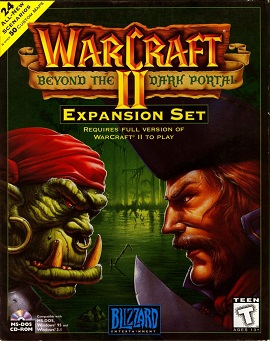
Warcraft II: Beyond the Dark Portal is an expansion pack for the real-time strategy video game Warcraft II: Tides of Darkness for MS-DOS, Microsoft Windows and Macintosh. It was developed by Blizzard Entertainment and Cyberlore Studios, and published by Blizzard in North America and Europe in 1996. It requires the full version of the original game to run and adds new story campaigns and multiplayer maps. The expansion was later released alongside Tides of Darkness for the PlayStation and Sega Saturn in 1997 as Warcraft II: The Dark Saga, and was included in the Warcraft II: Battle.net Edition for Windows PC and Macintosh in 1999.

World of Warcraft: The Board Game is an adventure board game based on the popular World of Warcraft MMORPG. The game was designed and published by Fantasy Flight Games in 2005.

The World of Warcraft Trading Card Game is an out-of-print collectible card game based on Blizzard Entertainment's MMORPG, World of Warcraft. The game was announced by Upper Deck Entertainment on August 18, 2005 and released on October 25, 2006. Players can play against each other one-on-one, or can join others in order to defeat dungeon/raid "bosses" based on those in the MMORPG. In March 2010, Upper Deck lost the license from Blizzard Entertainment. The license was acquired by Cryptozoic Entertainment later in the month, with the company announcing that planned card sets would be released.

World of Warcraft: Rise of the Horde is a novel by Christie Golden set in the Warcraft Universe. It was published in December 2006. Golden also has a commitment with Blizzard Entertainment and Simon & Schuster to write a StarCraft trilogy. Originally presumed to be the sequel to her previous 2001 book, Warcraft: Lord of the Clans, it depicts the draenei's escape from Argus and the rise of the Horde, following their shift from a shamanic race to a warmongering one. The book features major Warcraft characters, such as Durotan, Ner'zhul, Gul'dan, Orgrim Doomhammer, Kil'jaeden, and Velen. The story tells of how the orc clans and the noble draenei slowly become enemies due to deception and arrogance, and shows the downward spiral into which the orcs are thrown, and explores the role that demonic forces play in the Horde. It also expands on the origin of the Burning Legion, and the events preceding the first game of the Warcraft series.
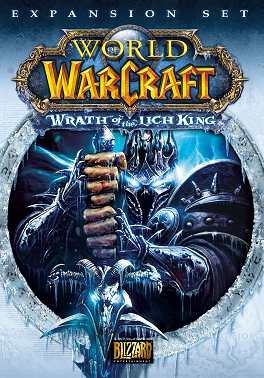
World of Warcraft: Wrath of the Lich King is the second expansion set for the massively multiplayer online role-playing game (MMORPG) World of Warcraft, following The Burning Crusade. It launched on November 13, 2008 and sold 2.8 million copies within the first day, making it the fastest selling computer game of all time released at that point. The game added a substantial amount of new content into the game world, including the new continent of Northrend, home of The Lich King Arthas and his undead minions. In order to advance through Northrend, players were required to reach at least level 68, with the level cap for the expansion being 80. The first hero class was introduced, the Death Knight, that starts at level 55.
World of Warcraft, or WoW, is set in a fictional universe, its primary setting being the planet of Azeroth. The first expansion, The Burning Crusade, introduced a second planet, Outland. Wrath of the Lich King and Cataclysm expanded upon Azeroth and respectively added Northrend, the frigid northern continent of Azeroth, and drastically changed various other continents by destroying some and unveiling new ones. The next expansion, Mists of Pandaria, added Pandaria, the southern continent previously hidden behind a perennial mist cover. Warlords of Draenor introduced the planet of Draenor, a version of Outland in a different timeline before its partial destruction. The Legion expansion took adventurers to the Broken Isles, an island chain near the Maelstrom in the middle of the Great Sea, and the damaged planet Argus, the headquarters of the Burning Legion. The seventh expansion, Battle for Azeroth, added two new island continents to the center of Azeroth: Kul Tiras and Zandalar. The latest expansion, Shadowlands, introduced the eponymous Shadowlands, a realm composed of five major zones: Bastion, Maldraxxus, Ardenweald, Revendreth, and the Maw.

Illidan Stormrage is a fictional character who appears in the Warcraft series of video games by Blizzard Entertainment.
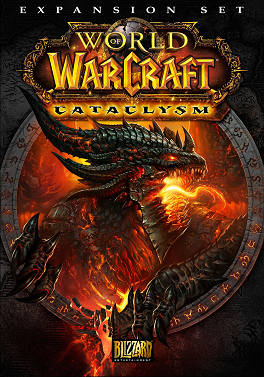
World of Warcraft: Cataclysm is the third expansion set for the massively multiplayer online role-playing game (MMORPG) World of Warcraft, following Wrath of the Lich King. It was officially announced at BlizzCon on August 21, 2009, although dataminers and researchers discovered details before it was announced by Blizzard. The expansion was released on December 7, 2010.

World of Warcraft: Warlords of Draenor is the fifth expansion set to the massively multiplayer online role-playing game (MMORPG) World of Warcraft, following Mists of Pandaria. It was announced on November 8, 2013 at BlizzCon 2013. The expansion was released on November 13, 2014.
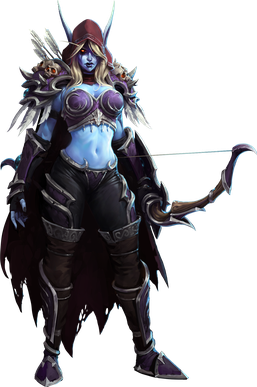
Sylvanas Windrunner is a fictional character who appears in the Warcraft series of video games by Blizzard Entertainment. Originally introduced in Warcraft III: Reign of Chaos, she received a dramatic redesign in World of Warcraft: Wrath of the Lich King, followed by a minor redesign in World of Warcraft: Legion. Once a high elf ranger-general of Silvermoon, Sylvanas was murdered by Arthas Menethil when she led a doomed resistance against his invasion. In one climactic battle, that left the capital city of Silvermoon in ruins, he managed to finally beat the elven general, ripping her soul out and transforming her into a banshee. This newest agent of the Lich King was empowered by hatred of the living and an everlasting desire to rule over her new people. In The Frozen Throne, Sylvanas was able to regain her free will and body, and founded the Forsaken faction of undead while styling herself as the "Banshee Queen" and "Dark Lady". With her new undead forces vowing to take revenge on the Lich King, they set out to wage war against the Scourge. Throughout nearly the entirety of Legion and the first one-third of Battle for Azeroth, she was also the Warchief of the Horde, standing as one of the most powerful political leaders in all of Azeroth following the death of Vol'jin during the opening events of Legion. She effectively abandoned the role in patch 9.1, Chains of Domination, resulting in the title of Warchief being retired and replaced by the Horde Council while leadership of the Forsaken is inherited by Desolate Council.
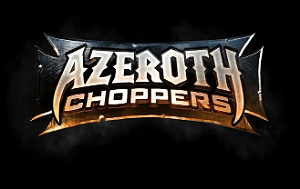
Azeroth Choppers was a weekly web series by Blizzard Entertainment that ran from April 17 to June 5, 2014. It featured Paul Teutul, Jr. and his company Paul Jr. Designs building motorcycles based on Blizzard's long-running MMORPG World of Warcraft.

Jaina Proudmoore is a fictional character who appears in the Warcraft series of video games by Blizzard Entertainment. Within the games, she is the most powerful sorceress alive. She is currently Lord Admiral, ruler of the Kul Tiras kingdom. Jaina was formerly the leader of the Kirin Tor, a faction of mages ruling over the city of Dalaran. She swore to defeat the Burning Legion and its sinister agents any way she could and helped defeat and banish the demons. Once a diplomat, she advocated for peace between the Alliance and the Horde, and she later joined the Alliance after the destruction of her city of Theramore at the hands of the Horde. The character has become one of the most iconic and noted characters in Warcraft lore, and has received positive critical reception from gamers. Jaina's other appearances include the collectible card game Hearthstone and the crossover multiplayer online battle arena video game Heroes of the Storm. Jaina was voiced by Carrie Gordon Lowrey in Warcraft III: Reign of Chaos and World of Warcraft, and is currently voiced by Laura Bailey in the subsequent World of Warcraft expansions, Hearthstone, and Heroes of the Storm.

World of Warcraft: Legion is the sixth expansion set in the massively multiplayer online role-playing game (MMORPG) World of Warcraft, following Warlords of Draenor. It was announced on August 6, 2015 at Gamescom 2015. The expansion was released on August 30, 2016.

World of Warcraft: Battle for Azeroth is the seventh expansion pack for the massively multiplayer online role-playing game (MMORPG) World of Warcraft, following Legion. It was announced at BlizzCon on November 3, 2017. In contrast to previous expansions, which went live at midnight in each time zone, Battle for Azeroth had a simultaneous release for all regions, corresponding to midnight Central European Summer Time on August 14, 2018.

World of Warcraft Classic is a 2019 MMORPG video game developed and published by Blizzard Entertainment. Running alongside the main version of the game, Classic recreates World of Warcraft in the state it was in before the release of its first expansion, The Burning Crusade. It was announced at BlizzCon 2017 and was released globally August 26, 2019. The Burning Crusade Classic and Wrath of the Lich King Classic versions of the game were later released to allow players to progress to those expansions.
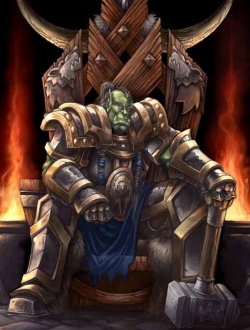
Thrall, born as Go'el, is a fictional character who appears in the Warcraft series of video games by Blizzard Entertainment. Within the series, Thrall is an orc shaman who served for a time as a Warchief of the Horde, one of the major factions of the Warcraft universe, as well as the leader of a shaman faction dedicated to preserving the balance between elemental forces in the world of Azeroth known as the Earthen Ring. Originally introduced in promotional material released by Blizzard Entertainment as the protagonist of the canceled video game Warcraft Adventures: Lord of the Clans, which was co-developed by Blizzard and Animation Magic from 1996 until 1998, Thrall's first proper appearance is in the 2001 novelization of the canceled video game's narrative authored by American novelist Christie Golden. The novel's story is set during his youth, where he is depicted as a slave who was raised by an abusive human military officer, but eventually rebelled and escaped captivity.


















